Mid-stage is no time to let your driver know his navigator has no damn clue what's going on.
My helmet has just been crammed into the cross ribs of the roof of our Miata for the third time in less than a kilometer, driving a guttural "OOMPH" from my lungs mid-sentence at the same time. I regain my breath, look from the route book to the kitchen timer that's Velcroed to the rally computer on the dash, and start counting out the seconds on my fingers. My tiny brain is already too overloaded for simple math, and I've reduced myself to elementary school tricks for quick calculations. It's the fifth stage of the fourth day, and the verdict isn't good; we're a far cry from our target time.
"We are 17 seconds slow," I say into the mic, doing my best to stifle any tones of urgency.
"Seventeen seconds? Are you sure?"
The short answer is that no, I'm not sure. For the first time in a full week's worth of time-speed-distance rallying, our time intervals are making no damn sense. We'll pass one and be 25 seconds down only to pass the next and be within five seconds of our target. I'm all kinds of crossed up, but mid-stage is no time to let your driver know his navigator has no damn clue what's going on.
"I'm sure. Beat on this thing."
Always project confidence.
Brandon Fitch drops the hammer on Nancy, our 2006 Mazda MX-5 Miata supercharged by the good people at Flyin' Miata, and we go plunging into a tight town section. The thrust is linear and sublime, and the vehicle's reworked suspension is doing its best to soak up the shattered, uneven pavement that leads into the town of Garnish before scrubbing speed for a hairpin, uphill left. I call off the next instruction.
We've lead the past three and a half days, and my stupid mistake has just demolished our chances of pulling off a podium finish.
"Into 100 meters, severe right, don't cut," I feel Brandon hesitate on the throttle and I look up – the ultimate no-no in the navigator's world – only to see a tangle of roads unraveling before the nose of the Miata.
"Severe right at the church. Head for the church," I say, trying to instill a little more confidence in our direction.
The acceleration piles on again, and soon the flying finish is in sight. There's only one problem: our timer says we still have 30 seconds before we're supposed to cross the finish line. I tell Brandon to burn the time, and we spend the next half-minute meandering back and forth across 150 meters of asphalt at 5 mph before crossing the line at what I thought was our assigned time.
It wasn't.
We were supposed to arrive at the flying finish in 8:43. I had transcribed 8:53 onto the route book, missing a crucial correction. When I finally realize my folly, the notion of my ignorance is crushing. We've led the past three and a half days, and my stupid mistake has just demolished our chances of pulling off a podium finish on our first visit to the Targa Newfoundland. It's nauseating.
The Targa Newfoundland has been tracing the coves and harbors of the most eastern North American land mass for the past 10 years. Originally conceived as the northern hemisphere's answer to the Targa Tasmania, the Targa Newfoundland has established itself as a well-organized event with a reputation for allowing drivers to explore the limits of their vehicles on public streets in a somewhat safe environment. An army of 2,000 volunteers work to secure courses, usher onlookers out of potentially dangerous zones and make sure that every car starts within its allotted time window. This year, over 60 vehicles took to the 2,200 kilometers of course across a myriad of classes. There is no other event in the world that can see a Dodge Viper ACR lined up against a 1969 Chevrolet Camaro, a Volkswagen Golf Trek, a Toyota AE-86 Corolla and a V8 Mazda Miata where each vehicle has an equal shot of taking home first place.

It's six days of stress, anxiety, fatigue and elation disguised as a motorsports event, and now that it's over, every waking moment is occupied with thoughts of exactly how I'm going to con my way into another ride next year.
There are no monetary prizes here, just the chance to participate in one of the world's most unique endurance rally events. At the end of the week, the victors go home with a laser-cut stainless steel trophy while those at the back of the pack take back what's left of their vehicle and a week's worth of memories tied to a truly life-altering experience. It's six days of stress, anxiety, fatigue and elation disguised as a motorsports event, and now that it's over, every waking moment is occupied with thoughts of exactly how I'm going to con my way into another ride next year.
I had originally planned to execute a nice, tidy summary of the week's event for the enjoyment of one and all, but seeing as how my feeble psyche is still having trouble processing the whole experience, we'll just have to settle for a day-by-day account of the 2011 Targa Newfoundland.
Day 1: Disaster Is My Classroom
In the spirit of coming clean, I should make it clear that until the 2011 Targa Newfoundland, I had never participated in any sort of competitive event, motorsports-related or otherwise. Ever. While the Open Road Motorsports Targa School had been a huge help in getting both Brandon Fitch, my driver, and I prepared for the grueling week to come, there was no bracing ourselves for the first real day of competition. We had spent the Prologue stages a day prior in a state of confusion and befuddlement, thanks largely to the fact that I was incapable of discerning between the timer and the odometer on the Terratrip rally computer.
As competitors in the dramatically less flashy Grand Touring division, we were charged with the task of hitting a specific time for each stage. Go too slow or too fast and we'd collect penalties. There was even the threat of Interim Time Controls, or ITCs, spread throughout each stage, with operations marshalls timing each car at predetermined points to ensure no one is just hauling ass for the first 3/4 of the route, then slowing down to make their time. As we would discover, it's much more challenging to be consistent than fast.
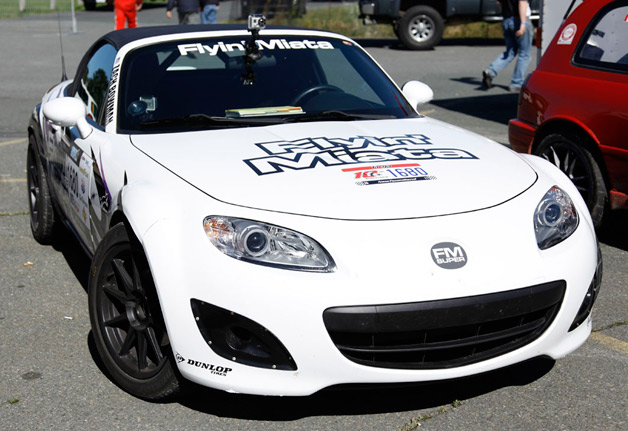
Fortunately, the organizers have built-in generous time windows at the beginning of the week to allow novice competitors like ourselves to get into the swing of things. On Monday, we could arrive up to 30 seconds before or after our target time. On Tuesday, that gap narrowed to 15 seconds, then down to nine on Wednesday, five on Thursday and finally a mere three seconds on Friday.
After picking the brains of veteran racers, we learned that the proper allocation of low-buck kitchen timers could greatly increase our chances of being in a position other than dead last. In addition, I had spent all of Sunday night furiously working out the time-speed-distance equations we needed for Day 1. Well, most of them. You see, in Targa, there are three road conditions. Condition 1 takes care of perfectly dry days while Condition 2 is left for light mist or fog. Condition 3 indicates that it's raining enough to caulk your wagon and float it across the majority of the stage. For the purposes of the Grand Touring class, Condition 2 and Condition 3 are lumped together with a common average speed and stage time, which are usually six percent slower than Condition 1.
Since the forecast called for sunny skies for the next three days, I hadn't bothered to work any of the time-to-arrival calculations for Condition 2 in an effort to save time and potentially sleep.
That, sirs, is what you call a rookie move.
As we rolled up to the very first stage, a fellow competitor casually mentioned that the marshals had set the stage to Condition 2. We had less than two minutes before we would be staring at the stage lights. I pulled open the glove box, yanked out the calculator and began squeezing my pitiful math skills with all my might in an effort to determine the actual stage time if it were six percent more than 4 minutes, 30 seconds. Let's be clear here: I was never a Math Olympiad participant. Hell, I couldn't even make the intramural team, so the prospect of dragging my forehead across a calculator in hopes of coming up with the correct answer was about as daunting as sprinting up Everest.
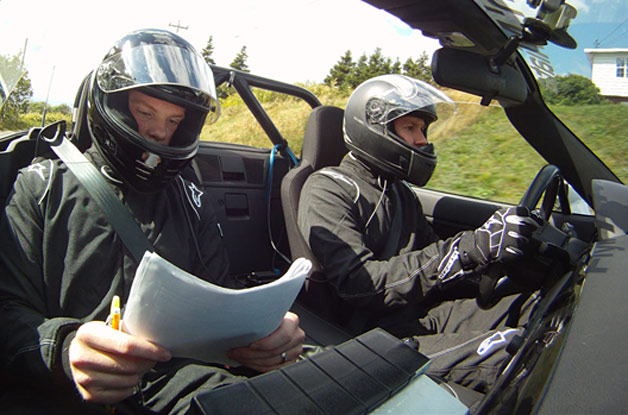
That's when Brandon plugged in his com and asked me to do the same. There was nothing. No static, no voices, not even the pathetic sound of my brain melting out of my ears. Something was wrong with the system. Brandon popped the battery cover only to discover that the 9V had been installed backwards the night before. Both prongs were bent. I returned my attention to my own second grade math class hell while Brandon furiously worked to get the com system back in order.
With less than a minute to go, I heard a slight pop, "There, can you hear me?"
As it turns out, 82.68 kph is six percent faster than the base speed of 78 kph. Whoops.
I could hear him, but I still hadn't worked out our average speed. Brandon offered to help, grabbed the calculator and quickly whipped up 82.68 kilometers per hour with just enough time to stash the office supplies and roll to the starting line. While we didn't have any accurate interval times to evaluate our progress against, we had the bare bones necessary to zero the stage. Or at least we thought we did.
As it turns out, 82.68 kph is six percent faster than the base speed of 78 kph – a fact we realized after hauling copious ass through the first half of the stage. Whoops.
By some merciful grace, we managed to zero the stage even with our mismatched calculations and harried instructions. Later, I would learn that the event organizers actually give you the average speed and time for Condition 2. It's on a separate page, in a separate book.
Face? Meet palm.
Thanks to the generous time window offered up by the organizers on day one and the fact that the rest of the stages throughout the day were all set to Condition 1, we managed to zero our times for the remainder of the day. Miracles happen, especially in the Targa Newfoundland.
Day 2: Gander and the sneaking feeling that we may be first
Now that we had established that we should always come prepared with times for Conditions 1 and 2 in every situation, it became clear that I was going to be getting a lot less sleep than I had anticipated. Day 2 promised a total of nine stages, each demanding their own time-speed-distance calculations for every instruction in the stage for both Condition 1 and Condition 2. Armed with my cheapy Staples calculator, I worked hunched over the route book until the wee hours of the morning, passed out for a few hours and awoke just in time to be bleary-eyed for the morning breathalyzer.
Brandon popped the clutch and promptly stalled the Miata. Shit.
We piled into the Miata and rolled out for the first few stages of the day. We managed to zero Appleton, which only bolstered the notion that we were beginning to get the hang of this whole Targa thing. Then we came to Bobby's Cove, the second stage of the day. With an average speed of 97 kph and just eight instructions for nearly eight kilometers of course, the stage offers plenty of easy, high-speed corners. We rolled to the start light and waited. The lights clicked red, then yellow, then green. Brandon popped the clutch and promptly stalled the Miata.
Shit.
For a split second, Brandon looked at the car like it had betrayed him, then hit the key. The engine fired to life with the clock still running.
"It's no problem. We can make up the time," I said over the com.
And make up the time we did. Brandon began caning the living snot out of the Miata, using every last ounce of forced-induction power to our benefit as we began closing the gap on our time intervals. The pine tree-stacked hills in my periphery were a blur and we were back on pace by 6.59 kilometers in.
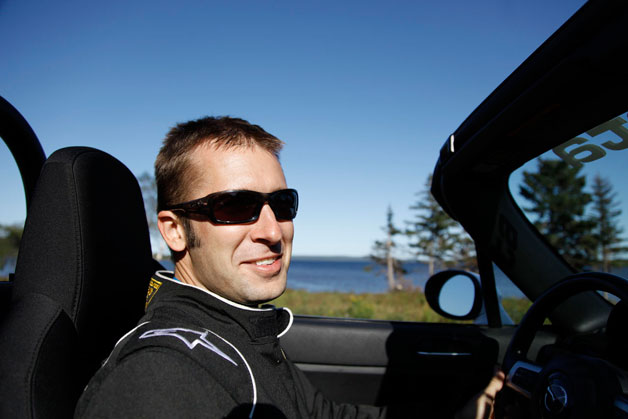
Brandon Fitch, driver of the Flyin' Miata Supercharged 2006 Mazda MX-5
Here's a fun fact: Grand Touring has a maximum targa speed of 130 kph (about 81 mph). Get caught exceeding that speed and the organizers will slap a penalty on you that will make your head spin. After we rolled through the flying finish and zeroed our time, Brandon checked the handheld GPS we were using to keep track of our average speed. After a few button pushes, Brandon pointed to the screen. Our max speed was 128 kph.
If this were an '80s montage, we'd be rocking out to Paul Engemann's smash hit, "Push it to the Limit."
The remaining stages were considerably less dramatic until we arrived at Gander. The stage is set in an honest-to-God subdivision, complete with forgettable sedans in the driveway, plush green lawns and steeply curbed asphalt roads. It's one of those stages that the old-timers of the event routinely talk about, and while the stages thus far had provided at least 500 meters between instructions, Gander was a maze of immediate 90-degree turns with typically less than 200 meters between calls. It would be a furious pace.
Sneaking thoughts of a podium finish began tickling at the periphery of our minds.
The lights turned green and I began reading off the instructions. As soon as Brandon saw the indicated turn, he would call out "Got it," giving me the cue to begin rattling off the next direction, and when possible, figure out where we were in correlation with our target time. After 7 minutes and 12 seconds of furious reading, calculating and whipping the car through the subdivision, we zeroed our time. When we came to a stop, my hands were shaking from the adrenaline of trying to be perfectly accurate and multitask for the duration of the course.
As per the schedule, we ran Gander a second time and repeated our flawless performance. When the organizers posted the results for Day 2, we noticed that we were once again tied for first place. Sneaking thoughts of a podium finish began tickling at the periphery of our minds.
Day 3: It's easy; just do everything perfectly right
By the time Wednesday rolled around, we had established an effective routine. I would write out our average speed in big block numbers on a piece of masking tape and stick it dead center in the middle of the dash for Brandon to read, then scrawl out the Condition 2 average speed and stick it on my side of the dash just in case there was a last-second switch. Then I would set the timer farthest toward the door to our target time and clear the second timer while we made our way to the start of the stage. Once on the scene, Brandon and I would go over any cautions or tricky bits on the course ahead while I reset the odometer and patiently waited for my anxiety levels to skyrocket.
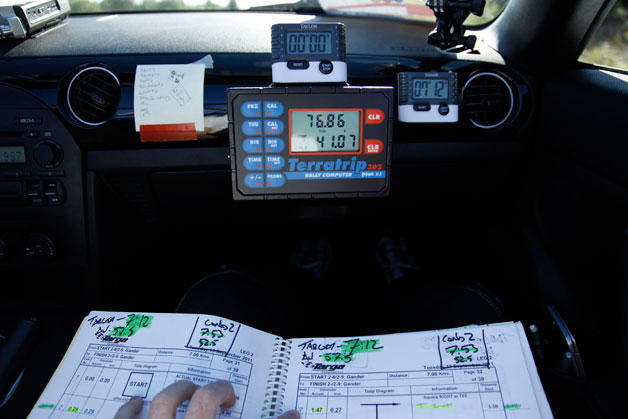
At some point during Day 3, we realized that we were, in fact, operating a fully functional street car, which meant we could enjoy amenities like air conditioning and even the stereo as we waited for our assigned start time. As it turns out, the only CD in the car was a burnt copy of the B-52s Cosmic Thing. Let's just say we were busy proving that there's nothing wrong with two guys in a purple-and-white Miata rocking out to "Love Shack."
I had greatly underestimated just how mentally intense this type of racing could be. Roll up to the start with calm nerves and a clear mind, and you were already leagues ahead of the rest of the field. Do the same dance in a rush, panicked that you've forgotten some small yet integral piece of the preparation puzzle, and you were almost doomed to face some kind of glitch.
I had greatly underestimated just how mental this type of racing could be.
That's exactly what happened on the infamous Greenspond stage. The previous course, Wesleyville, had gotten off to a late start, and as a result, we wound up arriving at Greenspond just in time to see the Hot Tour group take to the stage. We were to roll out promptly after those heathen machines, which left little time for things like gearing up, situating the com system, setting the timers and generally making sure we were prepped for the stage. As a result, I clicked the timers on before the yellow light fully extinguished. Our times were completely off for the short, technical stage, but Brandon was able to compensate by giving us enough time at the end to make our mark. Despite the error, we managed to zero the stage and avoid any ITC penalties.
The day wrapped up in Clarenville with two more subdivision stages on the same course. Much to our amazement, we still maintained a perfect zero score heading into the fourth day of competition. It was at this point that we realized we had a legitimate shot at the podium. Our system was now more or less ironed out, Brandon had an excellent command of Nancy's capabilities and we had been hitting our times well within the narrow margins of Day 5 even with the larger grace periods of Day 3. From this vantage, it looked like we could conceivably walk away with victory hardware from our very first Targa Newfoundland.
Thursday had other plans for us.
Day 4: The curse of Thursday
At this point, we had consumed a dizzying number of kilometers in both full-on race conditions and the more laid back transit pace between stages. The supercharged Miata was happy as could be being thrashed one second and cruising along with the AC on the next. Hell, we never even swapped brake pads for the entire race. The car offered the perfect balance of power and precision that made it custom-tailored for this kind of competition.
Thursday began under a blanket of dense fog and light rain for the very first time in the event, threatening to introduce another variable to our tenuous equation for success. Being from the high, dry desert of Colorado, Brandon's experience in the wet was somewhat limited. Fortunately, with plenty of stages doused in loose gravel on the apexes, he had already demonstrated a command of our vehicle's facilities in every direction – straight or otherwise.
As we rolled toward Boat Harbour, the first stage of the day, we began hearing a hearty clunk in the left rear suspension area every time we hit a bump. Chances were it was just something loose bouncing around in the trunk, but there was always the possibility that something crucial had worked its way free in the suspension geometry over the last five days of beating. When we arrived at the stage, Brandon hopped out to check out the noise. As it turned out, my camera was jittering off of the inside of the trunk with each impact, but the stroll to the rear of the car revealed another hitch in our giddy-up: the left rear tire had picked up a roofing nail at the very edge of the tread blocks near the sidewall.
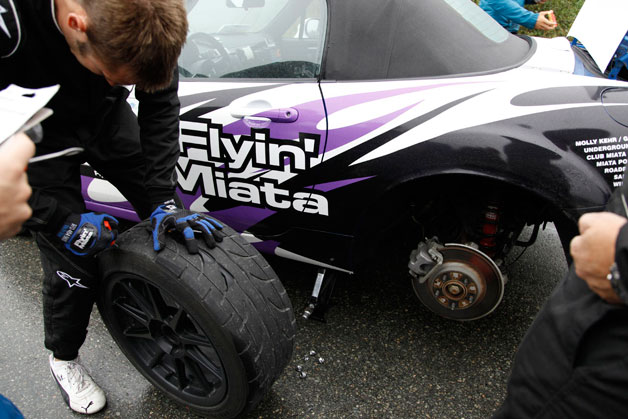
We checked the time. There was less than 15 minutes before the stage began. Brandon immediately got the Miata in the air and turned the electric impact wrench on the lug nuts. A fellow competitor managed to come up with a patch kit when Brandon thought to call our service crew. They were less than three minutes away and could be there in time with our full-size spare. Otherwise we would be forced to run on the factory space-saver. Images of unintended oversteer in the wet played through my mind.
When the service crew arrived, we pulled the wheel and tire from the truck, dropped it on the car and loaded up the old rubber for a quick patch job. We now had one tire running against its directional rotation, but we were otherwise back on the road with plenty of time to spare. We loaded up the tools, thanked those who were willing to lend a hand and headed for the start line.
We had just evaded potential mechanical calamity only to be held up by these yokels? I thought not.
The stage lights flashed red, then yellow, then began to count down when the two camera men on either side of the road began to walk in front of the vehicle to have a leisurely conversation about the weather.
I lost my mind.
We had just evaded potential mechanical calamity only to be held up by these yokels? I thought not. I began pounding on the windshield and screaming at the top of my lungs, through my closed-face helmet, which must have sounded something like an irate Kenny from South Park. The clock continued to count down to our start, and Brandon's ears were ringing with my profanities when the camera crew finally got the memo and bolted from in front of the vehicle. The lights flashed green and Brandon gave the car hell, inducing a little wheel spin and a quick side step before bolting into the course. Our odometer was now a little off, but we were otherwise on time. We zeroed the stage both going and coming as well as Mooring Cove, the third stage of the day.
Marystown South rolled up next – a stage made famous by its excellent spectator access. The course runs under a bridge at one point, allowing onlookers to take in the action from both sides of the raised structure. In Grand Touring, the fewer penalties you accumulate over the course of the week, the better your starting order. Since we had rocked the socks straight off days 1-3, we were at the front of the pack, right behind the supercars of the Hot Tour Group. The exotic metal roared away from the start, and two minutes later, we followed suit.
The stage was going flawlessly until around instruction 16, where we were to make a hairpin left before a barricade. I called the instruction only to hear Brandon mutter, "What is this guy doing?"
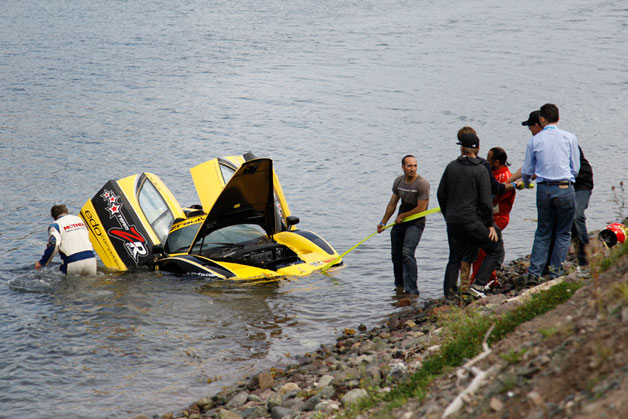
I looked up in time to see a marshal waving his arms and pointing in the direction of the course. At the time, we thought he was merely trying to be helpful, but as Brandon downshifted and brought the Miata around the corner, we noticed that something was definitely wrong. The Ferrari F430 Spyder that had started directly before us was pulled to the right side of the course, and the safety car that began the stage ahead of us was also stopped. A crowd was gathered at the top of a berm looking into the bay. As we got closer, we realized that the Ferrari Enzo was bobbing alongside a row boat. The car had gone into the water.
Both the driver and co-driver were fine, and both were attempting to keep the exotic from falling into the hands of the strong current and floating out to sea. We lent our tow rope to the anchoring effort and continued on to the next stage at the behest of the safety marshal. Seeing the Enzo up to its headliner in salt water was a quick reminder that we were competing in a form of motorsports where anything can happen at any time, and there was a palpable shift in everyone's attitude. The very next stage was the fifth of the day, Garnish – the scene of my erroneous timing that begins this tale.
We headed to Marystown North – the reverse of the stage that put the Enzo in the drink.
Knowing I had blown the Flyin' Miata's chances at a first-place finish in Grand Touring was a sour fact to swallow, but Brandon was quick to point out that we couldn't let one slip drag down the rest our week. We had led the class for three and a half days on our debut outing, and if we were careful from there on out, we had a good shot at seeing the podium. We zeroed the next two stages, knocked the reverse of Garnish out of the park after some quick double-checking and headed to Marystown North – the reverse of the stage that put the Enzo in the drink.
I flipped on the stereo to one of the surprisingly good classic rock stations floating around the air waves and waited for our start time. I was doing my best to keep both Brandon and my nerves in check after a shaky afternoon, and the goofy tunes were doing the trick. We helmeted up, killed the music and I went over the first few turns so that Brandon would have a better picture of our direction.
The lights turned green, we popped off of the line with a nice, clean launch and headed to the first turn – a square left 240 meters into the course. I called the instruction, received a "Got it" from Brandon and began to focus on the next – a single caution, crest into T right with an exposure to the same bay that had claimed the Enzo, when I caught a volley of curses from the driver's seat.
I looked up to see a wall of red tape – we had overshot our turn. Brandon flipped the Miata around in the street, and with our odometer reading already well off, wasted no time in sliding the car in the proper direction. We were now well off of our target time, and Brandon began giving the Miata hell in an effort to catch up. For the first time in a week, I caught the cheers of spectators floating through the cracked windows of the Mazda as we sailed past. Eventually, I realized that I could use the turns themselves to calculate an approximate arrival time instead of the odometer reading and began calling out whether or not we were fast or slow, but not until we had already blown past an ITC well outside of our window.
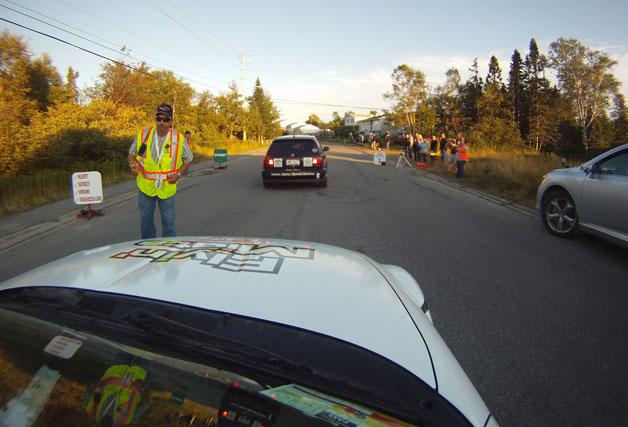
We rolled across the finish line just as our stop watches chimed zero, but we picked up a healthy seven seconds in penalties from the first ITC alone. All told, we had snagged 14 seconds over the course of the day, effectively knocking ourselves from first to fifth.
Meanwhile, our sister team in the V8-powered Targa Miata met with ill fortune of its own. The main relay, a stock Miata part, had given up on the very last stage of the day, causing the car to coast to a stop just before the bridge and all of its spectators. The relay had cost Keith and Janel their shot at a Targa Plate, the symbolic award that comes with completing every stage in the rally, as well as any hope of taking first place. The two were leading the open class until then.
Day 5: Into the storm
Despite our brush with foul weather on Thursday morning, the entire week had offered nothing but blue skies and sunshine – nothing short of a meteorological miracle if the locals were to be believed. Word was we were going to pay for our good fortune in time, and tropical storm Maria was just the girl to make us ante up. Friday opened to a full-blown maelstrom, complete with driving rain, howling winds and the realization that wide tires on a lightweight convertible is the perfect recipe for hydroplaning. I checked the bulletin board for any notice of stage closure before Brandon and I packed into Nancy for the last day of competition. When we left the convention center, all stages were still go for action.
On the way out to the first stage of the day, wind whipped the standing water on the road into frothy white caps, bent and broke the trees on the side of the road and generally made driving an exercise in patience. Before we could reach the start of the first course, a stage operations vehicle motioned us to a stop. The conditions were simply too bad to compete in, so stages one through three were scrapped in hopes that the weather would turn cooperative.
We headed to the town of Carbonear for what would be the first stages of the day, which left us plenty of time to pre-scout the route along with the other competitors. We wouldn't be missing any turns this time around. By the time the course was locked down and we had eaten lunch, the pavement had dried to Condition 1 and we were free to go frolicking through suburban neighborhoods and downtown city streets. We zeroed both our stages, but a logistical error on the part of the organizers caused the first run to be thrown out altogether.
From there, we headed to the legendary stage of Brigus – a tiny town with winding, narrow streets, lots of elevation change and typically less than 100 meters between instructions. It would take a focused effort to avoid any penalties on the course, and as we rolled up, Maria blew with all of her might onto the stage. There was standing water on the course, but we were going ahead anyway.
The lights rolled green, I glued my eyes to the route book and felt the Miata skip across expanses of water before slowing to a crawl. I looked up from my instructions just in time to see Brandon whip the nose of the car toward the world's narrowest bridge before deciding that I was better off not seeing what was coming. I stuck back to the book and continued to call instructions as we plowed through the course. Three kilometers and 3 minutes, 43 seconds later, we were across the line with no penalties for the day.
In 41 stages of competition on our very first year to the Targa Newfoundland, we had made just two penalty-worthy mistakes and collected a mere 14 seconds of time with zero mechanical issues whatsoever. We were damn proud of ourselves.
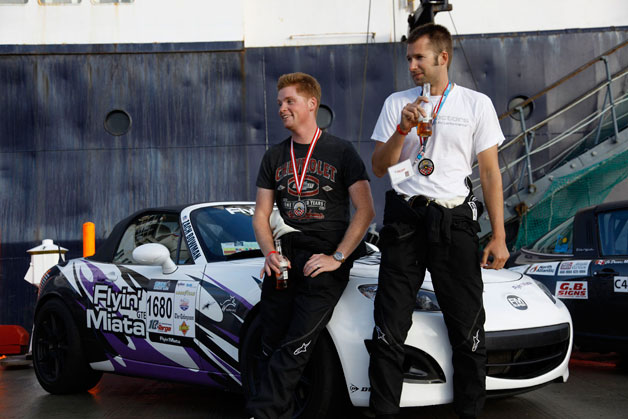
Every competitor convoyed in a parade from Brigus back to St. John's for the ceremonial finish and the bestowing of completion medallions. As we rolled toward the crowd, Brandon and I dropped the top on the Miata as the first rays of sunshine broke through the cloud cover. It was perfection. With the heavy medallions around our necks and broad smiles on our faces, we shook hands with our fellow competitors, congratulated them on one hell of a rally and generally enjoyed the camaraderie that goes with having not only survived, but having succeeded at the 2011 Targa Newfoundland.
That night, we discovered that two local boys, Justin Crant and Justin Russell in their VW Golf Trek, had managed to zero every stage in the competition – a feat worthy of more than one congratulatory beer. The guys were incredibly helpful throughout the rally, which meant that we couldn't think of a better team to take home the gold. As for us, we held on to our fifth place overall standing, which brought along a bittersweet cocktail of emotions. Yes, we had done a phenomenal job on our very first time-speed-distance rally, but at the same time, we had also come painfully close to taking the gold. We were elated and crushed at the same time.
And then we won a trophy...
Saturday night brought the awards gala, and we knew that Keith and Janel would be taking home third place in their class. Brandon and I, meanwhile, were just along for the free meal, or at least we thought we were. As it turns out, the Grand Touring class awards what's called the Grace Cup for novice competitors with the highest final standing that showed the most heart in the spirit of Targa. It's effectively Rookie of the Year for Targa Newfoundland, and this year, Brandon and I took home the trophy for the Flyin' Miata team.
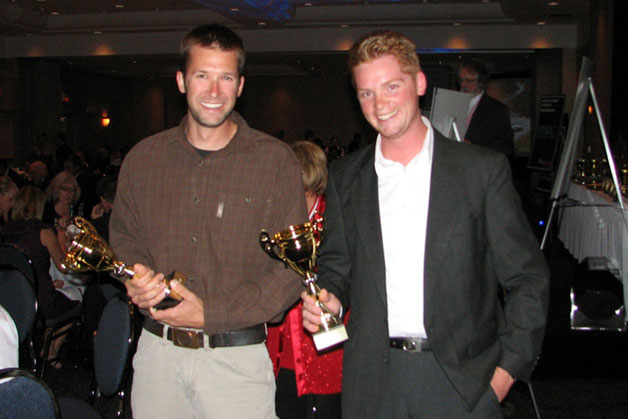
I know it's just a symbol, but having a physical acknowledgement of the long hours, unending work and unabated drive to succeed from the past week in my hands was an unreal experience. The smile is still welded to my face. Having come so close to taking the gold, meeting so many awesome competitors who will undoubtedly prove to be lifelong friends and generally forging memories that will stick with me until they plant me below ground all but guarantee that I'll be back to Targa Newfoundland. If not next year, then at some point in the future. It just has to happen.










Sign in to post
Please sign in to leave a comment.
Continue